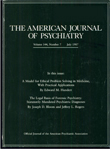Neuroanatomical correlates of externally and internally generated human emotion
Abstract
OBJECTIVE: Positron emission tomography was used to investigate the neural substrates of normal human emotional and their dependence on the types of emotional stimulus. METHOD: Twelve healthy female subjects underwent 12 measurements of regional brain activity following the intravenous bolus administration of [15O]H2O as they alternated between emotion-generating and control film and recall tasks. Automated image analysis techniques were used to characterize and compare the increases in regional brain activity associated with the emotional response to complex visual (film) and cognitive (recall) stimuli. RESULTS: Film- and recall-generated emotion were each associated with significantly increased activity in the vicinity of the medial prefrontal cortex and thalamus, suggesting that these regions participate in aspects of emotion that do not depend on the nature of the emotional stimulus. Film-generated emotion was associated with significantly greater increases in activity bilaterally in the occipitotemporparietal cortex, lateral cerebellum, hypothalamus, and a region that includes the anterior temporal cortex, amygdala, and hippocampal formation, suggesting that these regions participate in the emotional response to certain exteroceptive sensory stimuli. Recall-generated sadness was associated with significantly greater increases in activity in the vicinity of the anterior insular cortex, suggesting that this region participates in the emotional response to potentially distressing cognitive or interoceptive sensory stimuli. CONCLUSIONS: While this study should be considered preliminary, it identified brain regions that participate in externally and internally generated human emotion.



